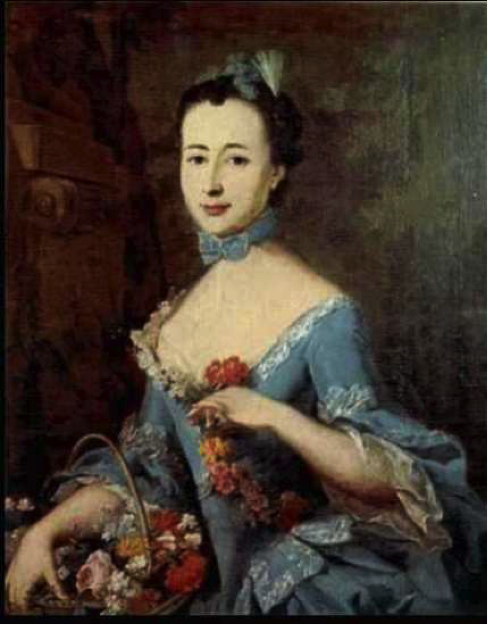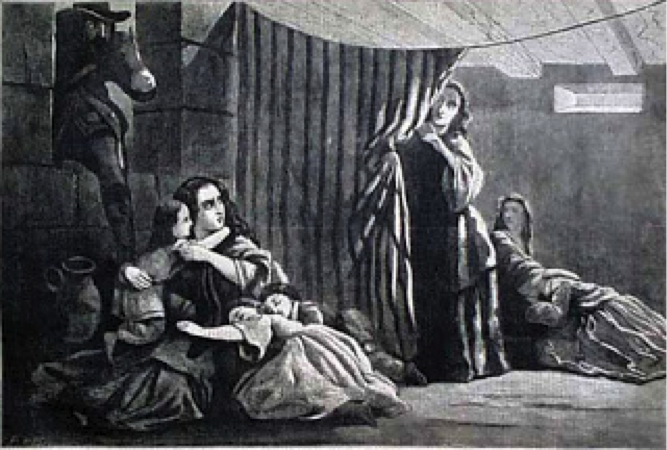
Laura's Blog

The courage and love of the Hessian Baroness von Riedesel
March 25, 2018

You will meet Baroness Frederika von Riedesel in Chapter Seven of HAMILTON AND PEGGY!, when Catharine Schuyler hosts the defeated British General Burgoyne and his entourage for several days after the Battle of Saratoga. Burgoyne had burned the Schuyler’s country estate in Saratoga during the fight, so Philip had remained there to rebuild the house, its barns and mills before the onset of winter. So Catherine was required to entertain her enemy in their Albany mansion without the presence of her husband, who had magnanimously invited the defeated the general and his staff officers to stay. I just couldn’t imagine Catharine being particularly happy about that! The friction that must have existed between the hostess and her British and Hessian POW guests presented the perfect opportunity for me to show during their first dinner together Peggy’s renowned “wicked wit” and her ache to be part of the rebellion’s narrative—even if it was simply a war of words at the dining room table.
Sadly, my next passage with the Hessian general’s wife ended up on the cutting room floor. It about broke my heart, because it was a scene of reconciliation and empathy between her and Catharine that embodied those across-enemy-lines moments of mercy and bonding that I have read of repeatedly during my research into various wars for my novels. But it had to be done to keep the novel flowing. The Baroness was one of those fascinating and poignant real life characters who pulled the narrative’s spotlight too far away from Peggy, even momentarily.
So… I would like to tell you a little about the Baroness here! Her devotion to her husband, her courage under fire, her ability to remain compassionate when terrified and in horrific danger, is truly astounding. Perhaps especially since it goes against our nation’s stereotype of Hessian troops.
The daughter of a Prussian general, Fredericka Charlotte Louise von Massow married a nobleman-soldier when she was 16-years-old and he 24. (The portrait above shows her as a bride, represented as “Spring.”) He rose to be a Hessian general. When he deployed to America to join Burgoyne’s Redcoats, she followed, bringing along three young daughters, a 6-year-old, 3-year-old, and a 2-month old baby. While here, the Baroness kept a detailed journal of her harrowing experiences, which historians praise as being one of the most complete and accurate accounts of Burgoyne’s campaign.
I was completely riveted by her memoirs, beginning with her description of landing at Quebec and then traveling through the wilds of Canadian forests to find her husband’s camp. A snippet of her description of a canoe passage will show you why:
“There was nothing left for me to do but to climb into the canoe. I held my three children in my lap and my three servants on the opposite side. We had to keep absolutely balanced, but our boatman did not tell me this until suddenly a heavy hailstorm came up, which frightened my little Frederika so that she cried out and wanted to jump up from my lap. Then he told me that the slightest move we made could overturn the boat. I, therefore, had to hold her tight and not mind her crying; thus we finally arrived safe at the Trois Rivieres that evening, where our officers threw up their hands in horror, and I learned only then in what danger we had been. Two gentlemen had gone fishing and when the storm came up their canoe had upset, and they were both drowned. I thanked God for having protected us, but this made me afraid hereafter to cross the tiniest stream even in the finest weather.”
But cross them she did as a “camp follower” on the 300+ mile trek from the province of Quebec to the Saratoga battlefields. Along the way the baroness endured more horrendous storms (“ as though we were in a caldron”) and frightening encampments, like the one of “Rattlesnake Island.”
“I noticed that one of the soldiers had put a kettle on the fire. I asked him what was in it. (potatoes) I cast a longing glance at them. He had only such a few that I thought it would be cruel to deprive him of any, particularly as he seemed so happy to have them. In the end, however, my inordinate desire to give the children something to eat got the better of my modesty, so I begged him for some…in addition he gave me two or three bits of candle from his pocket and gave them to me which made me very happy, as the children were afraid of the dark….I heard noises all night…(the Hessians had learned too late of the rattlesnake population to leave, the currents had grown too strong) there was nothing left but to build big fires and make as much noise as possible, in order to frighten the snakes and thus keep them away…in the morning we found the skins and slime of these horrible reptiles all over…”
During the multiple battles of Saratoga, the Baroness would pay back the soldiers’ protectiveness of her and her children with what tea and food she had left. She nursed their wounds, and soothed them as they writhed in pain. Her account of hiding in a cellar during the battle is bone-chilling—“Little Frederika, was very much frightened, often starting to cry, and I had to hold my handkerchief over her mouth to prevent our being discovered… My children lay on the floor with their heads in my lap. And thus we spent the whole night. The horrible smell in the cellar, the weeping of the children, and, even worse, my own fear prevented me from closing my eyes…Eleven cannon balls flew through the house, and we could distinctly hear them rolling about over our heads.”
She would also describe the moans of a man whose legs were severed as a cannon hurtled through the house, the death of a general and having to spend a day beside his corpse during a seemingly endless bombardment. Always, however, her observations are infused with tender and moving insights to the good mankind is capable of even in such terrorizing moments—including the scene of a Hessian officer making silly animal sounds to amuse and distract her children as they huddled in the dark, listening to explosions and musket fire all around them.

An 1857 Harper’s Weekly depiction of the Baroness and her children taking refuge in the Marshall House during the Battle of Saratoga.
Those are the kinds of revelations I wrote the Baroness sharing with Catharine—mother to mother—as she rocked her three tiny daughters to sleep in front of the Schuyler’s hearth. Catharine, after all, had traveled deep into New York’s wilderness to nurse Philip when he was ill with gout. The two women clearly shared an intrepid devotion to their husbands. In my now deleted scene, the Baroness’ recounting melts Catharine’s rather formidable heart, allowing the women to part not necessarily as friends but in a truce of mutual respect.
I knew I could give that scene to the Baroness because she diligently made note of the many kindnesses she received at the hands of her American captors—which had surprised her. She had expected far worse mistreatment from her “rebel captors.” The Baroness had been jeered and dangerously harassed in England, by comparison, for simply wearing French-style clothes while she was there awaiting her ship for Canada.
Closely replicating what she wrote in her journal, I had the Baroness say (in the dinner party scene which does remain in my novel!) how she marveled at the fact Continental soldiers had not threatened her. “I must admit that when I rode into your camp, after our army’s capitulation. I feared jeering, or…or worse. But not one American glanced at us insultingly. In fact, your soldiers bowed to me. Some even looked with pity to see a woman with small children there. I…I am afraid that might not have been the scenario had the reverse been true and your men were our prisoners of war.”
Perhaps that is what prompted the Baroness to name her fourth daughter—born in NYC in 1780, while she and her husband still awaited extradition—“America.”
Her letters and journal bear palpable witness to the Revolution from a civilian, female, and “Loyalist” perspective and are well worth the read: Journal and Correspondence of a Tour of Duty, 1776-1783. You can find them here:

Other Blog Posts
Click Here to See All of Laura's Blog Posts
